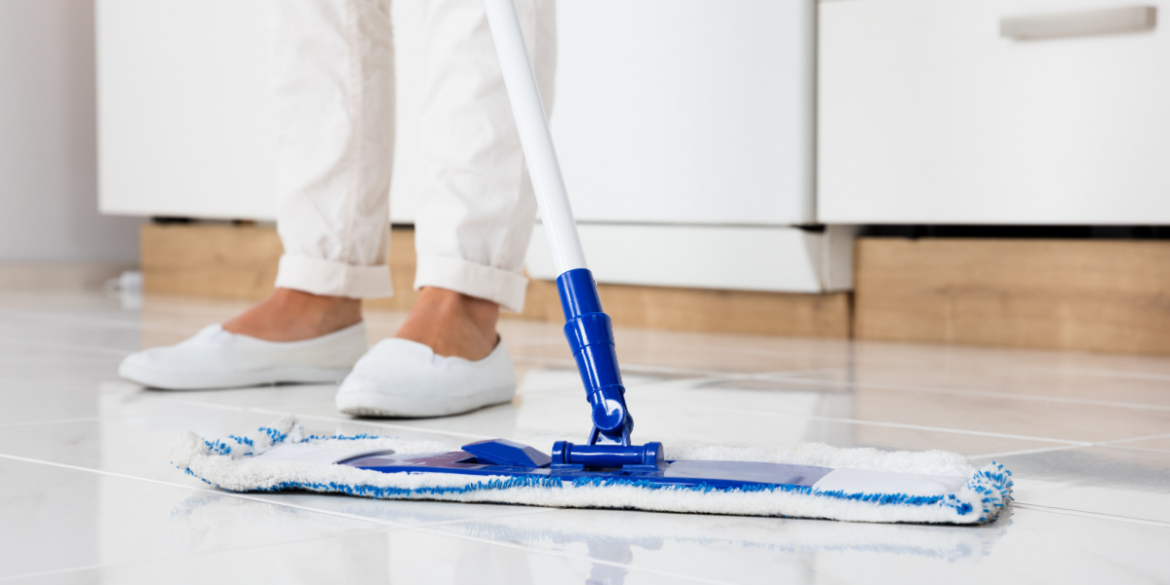Tired of watching your once-pristine floors become dull and grimy? Finding the right mop for tile and wood floors can make a world of difference. Whether you have a bustling family or a minimalist lifestyle, the quest for a clean and sparkling floor is universal. But with so many mops on the market, where do you even begin?

Image: www.theorganizeruk.com
This guide is your roadmap to selecting the ideal mop for your tile and wood floors. We’ll dive into the different types of mops, their pros and cons, and factors to consider when making your choice. Get ready to say goodbye to dirt and hello to sparkling floors!
Types of Mops: A Comprehensive Guide
The world of mops is surprisingly diverse. Let’s break down some of the most popular types and explore their strengths and weaknesses:
1. String Mop
The traditional string mop is a trusty workhorse in many homes. It’s a simple design with a bucket for soaking the strings and a wringer for removing excess water. But the simplicity isn’t always a virtue:
- Pros: Inexpensive, readily available, good for general cleaning
- Cons: Can be difficult to maneuver around furniture, strings can trap dirt, may not clean deep enough, risk of spreading germs if not thoroughly cleaned
2. Spray Mop
Offering more control and convenience, spray mops feature a built-in sprayer for dispensing cleaning solution directly onto the floor. They often have microfiber pads that are reusable and washable.
- Pros: Easy to use, lightweight, good for quick cleanups, adjustable cleaning solution concentration
- Cons: May not be suitable for heavily soiled floors, water tank can be small, requires refilling frequently

Image: www.theorganizeruk.com
3. Steam Mop
The steam mop harnesses the power of steam to loosen dirt and grime. It kills bacteria and sanitizes without harsh chemicals, making it perfect for homes with pets or allergies.
- Pros: Deep cleaning, sanitizing, uses less water, eco-friendly
- Cons: More expensive than other options, can be heavy, heating time required, not suitable for certain floor types
4. Spin Mop
With a built-in spinning mechanism, the spin mop wrings out excess water from the mop head, making it ideal for sensitive floors like wood, which can warp with too much moisture.
- Pros: Easy to use, less water needed, suitable for wood and other delicate surfaces
- Cons: Can be difficult to clean the spinning mechanism, may not be strong enough for heavily soiled floors
5. Robot Mop
For the ultimate in convenience, consider a robot mop. This hands-free cleaning solution navigates your floors autonomously, offering a clean and effortless experience.
- Pros: Hands-free cleaning, convenient for busy lifestyles, can clean under furniture
- Cons: More expensive than traditional mops, may not reach every corner, requires regular maintenance
Choosing the Right Mop for Your Needs
Now that you understand the different mop types, it’s time to select the best one for your specific needs. Here are some key factors to consider:
1. Floor Type
Wood floors require a gentle touch and minimal moisture, making spin mops and spray mops suitable options. Tile floors, on the other hand, are more robust and can handle more vigorous cleaning with steam mops or string mops. Always consult the manufacturer’s instructions for your specific floor type.
2. Cleaning Needs
For casual cleaning, a spray mop or robot mop might suffice. However, if you are facing deep-seated grime, a steam mop or a classic string mop may be a better choice. Consider your cleaning frequency and the amount of dirt and grime you expect to encounter.
3. Budget
Mops range in price from budget-friendly string mops to high-tech robot mops. Set a budget and stick to it. Remember, pricier doesn’t always mean better, and a quality spray mop can deliver excellent results without breaking the bank.
4. Size and Layout
The size of your home and the layout of your floors will influence your mop choice. For smaller spaces, a compact spray mop might be ideal, while larger homes may benefit from a longer reach spin mop or even a robot mop.
Maintaining Your Mop: Keeping It Clean and Effective
A clean mop is essential for maintaining your clean floors. Follow these general maintenance tips:
- Wash or replace mop pads regularly – A dirty mop pad will spread dirt instead of cleaning it. Microfiber pads are generally washable, while cotton or string mops often need replacement after frequent use.
- Rinse and dry your mop handle – Bacteria can breed in a damp mop handle. Always rinse it after use and allow it to dry completely before storing.
- Clean and disinfect the bucket – If you use a traditional string mop or bucket system, make sure to clean and disinfect the bucket after every use to prevent the growth of bacteria and mold.
Best Mop For Tile And Wood Floors
The Bottom Line: Choosing the Perfect Mop for You
Ultimately, the best mop for tile and wood floors is the one that fits your lifestyle. Consider your floor types, cleaning needs, budget, and space. Whether you opt for the timeless string mop, the convenient spray mop, or the innovative steam mop, remember that the most important factor is keeping your mop clean and effective.
Now that you’re armed with the knowledge to choose the right mop for your home, go get cleaning! And remember, a sparkly clean floor is just a mop away.






